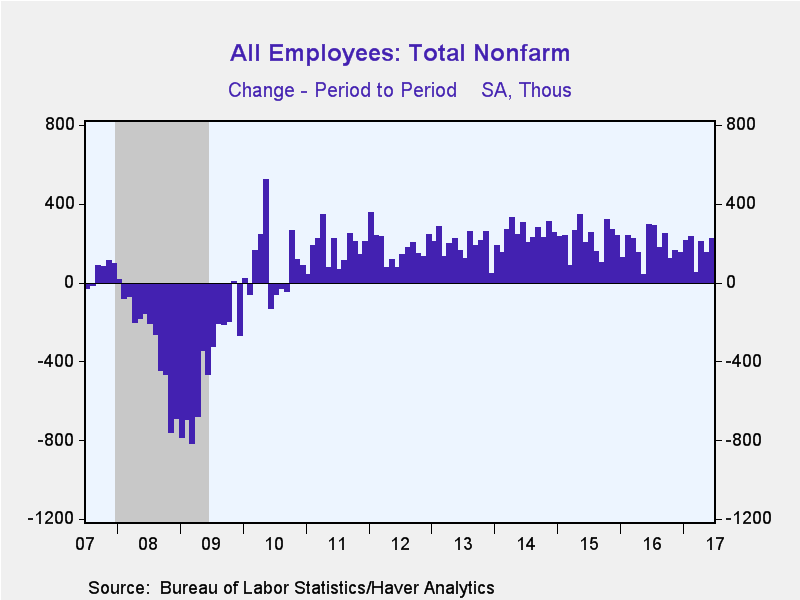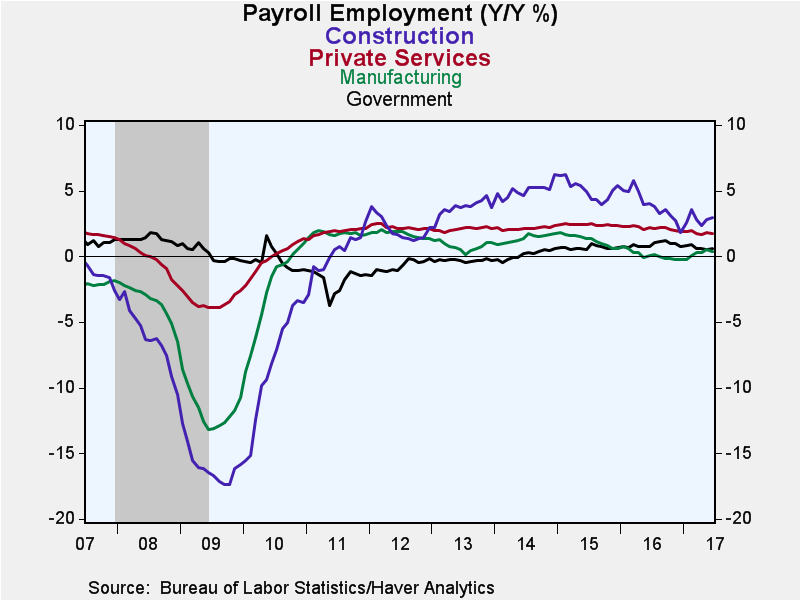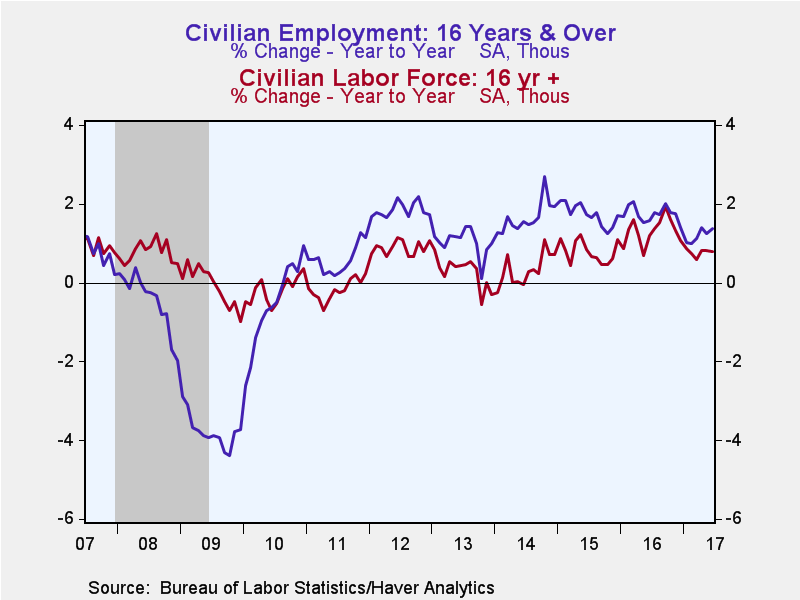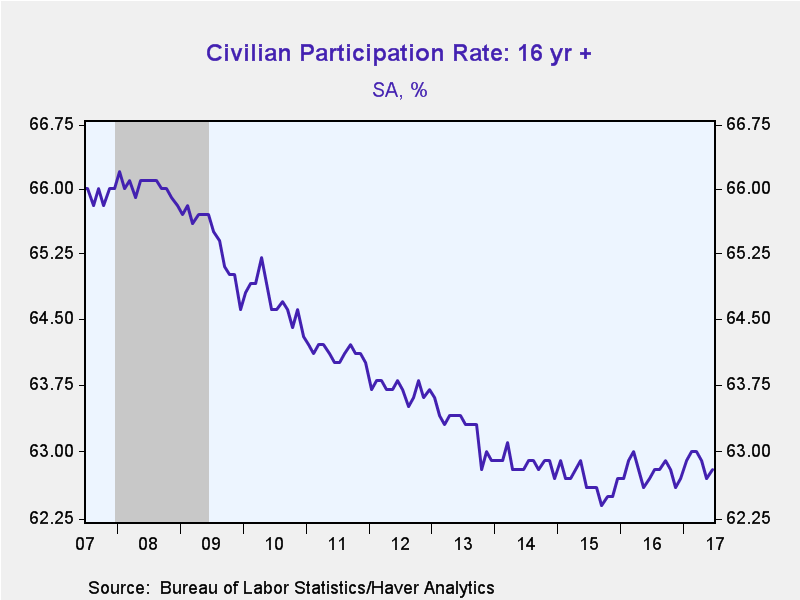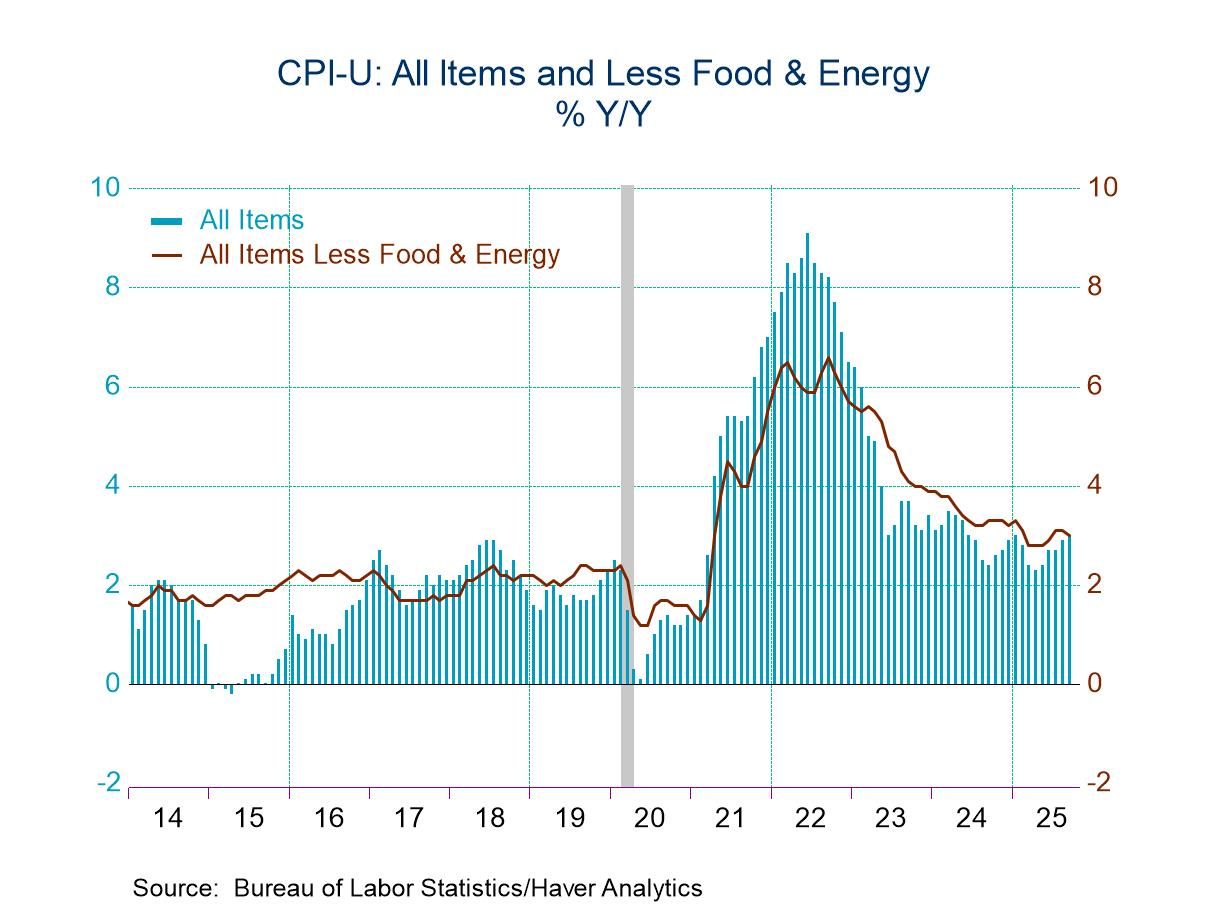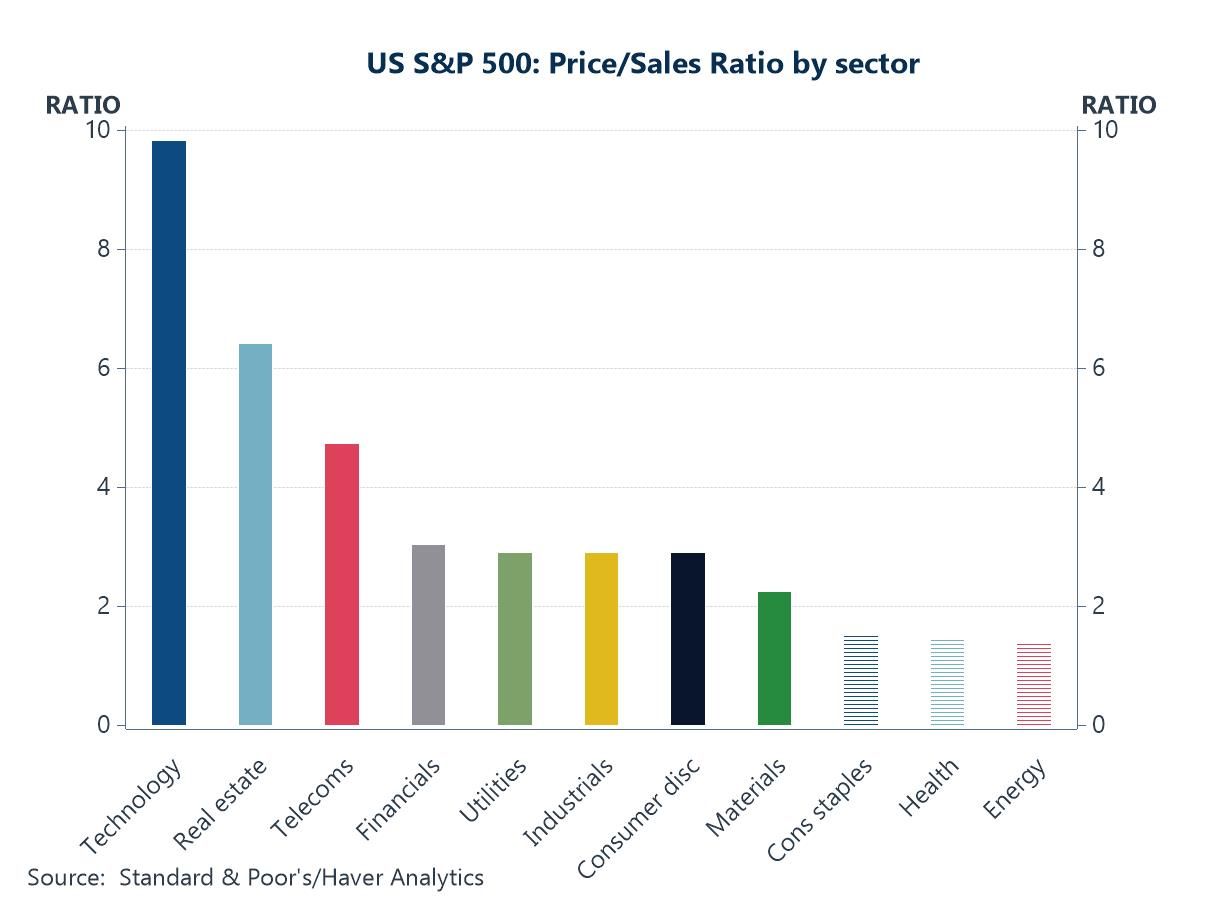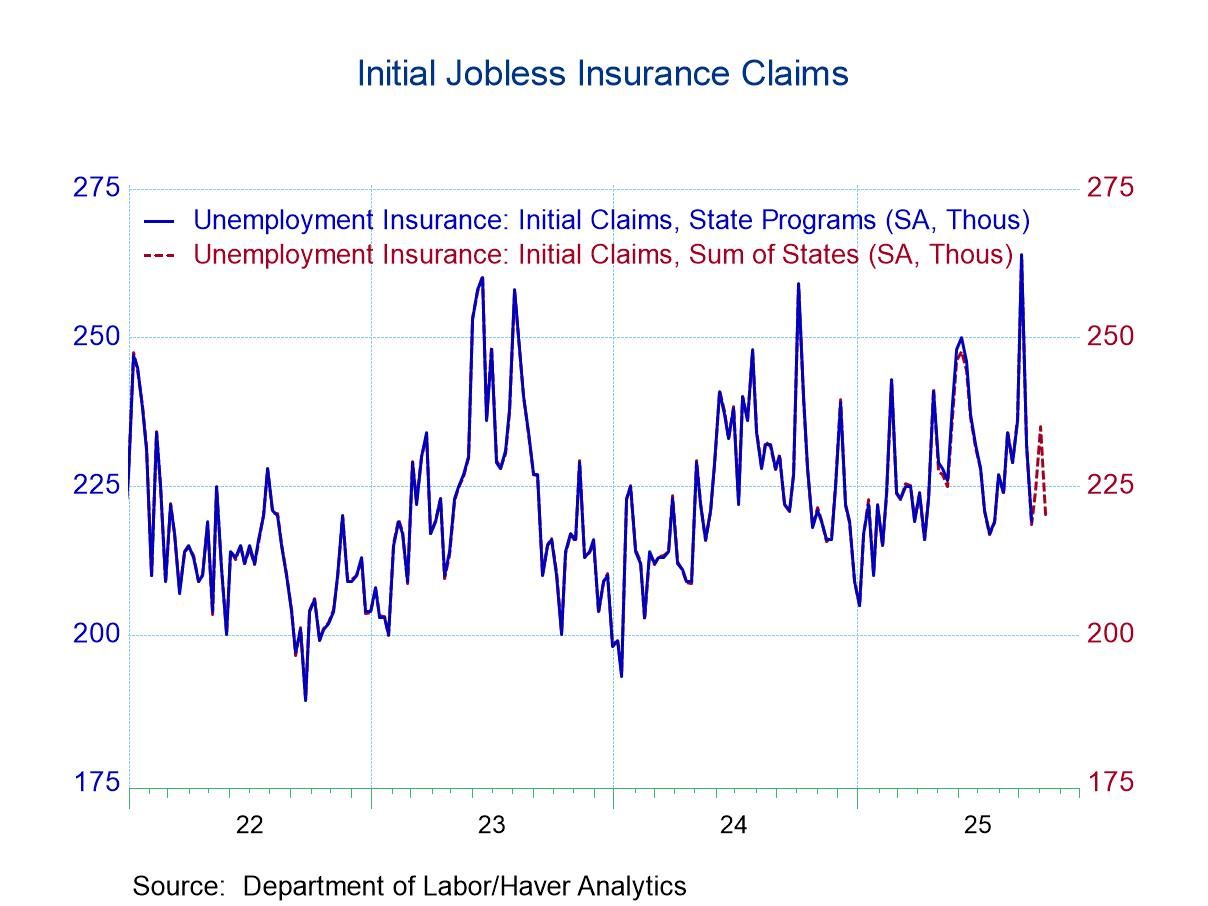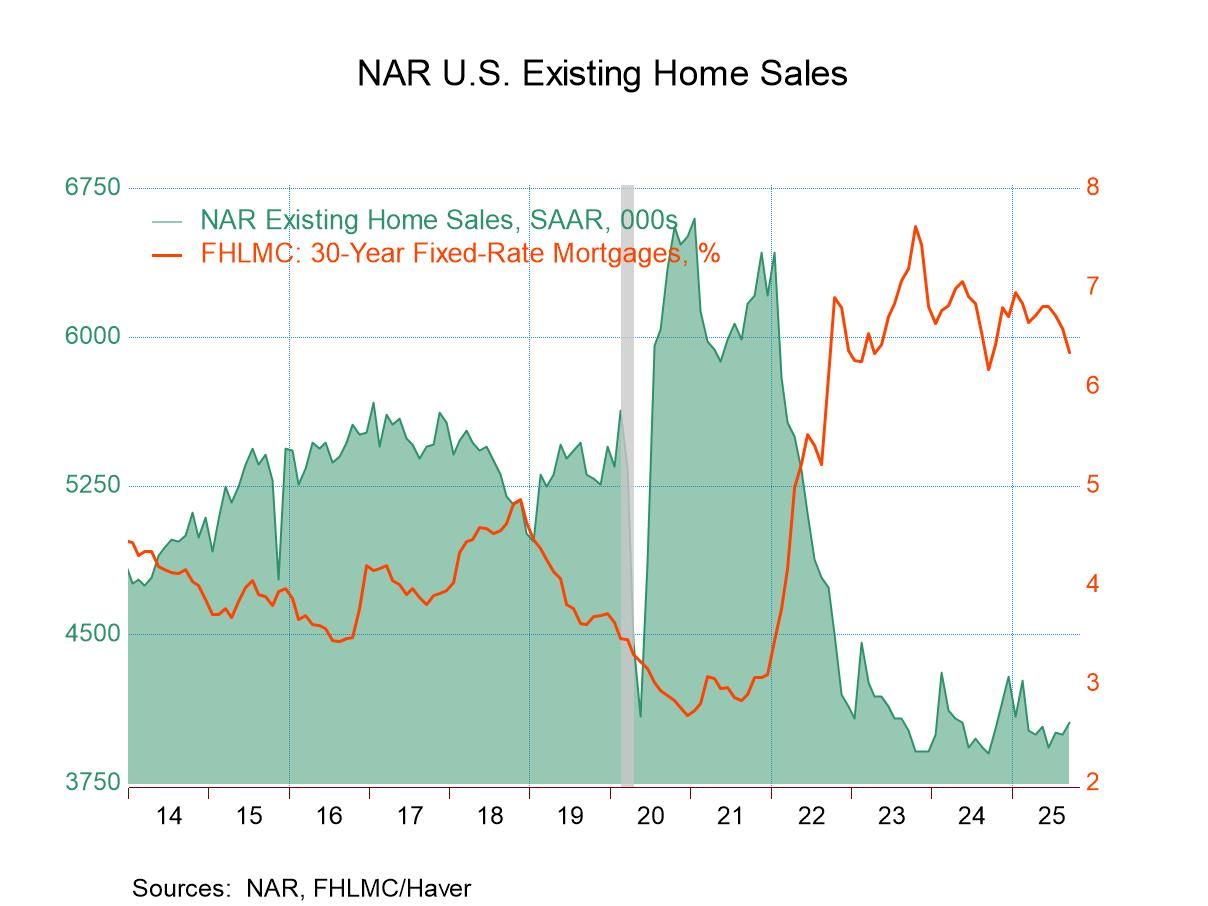 Global| Jul 07 2017
Global| Jul 07 2017U.S. Payroll Increase Improves; Jobless Rate Edges Higher
by:Tom Moeller
|in:Economy in Brief
Summary
Nonfarm payrolls rose 222,000 (1.5% y/y) during June. It was the strongest gain since February. A 180,000 increase had been expected in the Action Economics Forecast Survey. The rise followed a 152,000 gain in May and a 207,000 April [...]
Nonfarm payrolls rose 222,000 (1.5% y/y) during June. It was the strongest gain since February. A 180,000 increase had been expected in the Action Economics Forecast Survey. The rise followed a 152,000 gain in May and a 207,000 April rise. Together these figures were revised up by 47,000. Hiring activity was mixed amongst sectors. Average hourly earnings rose 0.2% (2.5% y/y) after a 0.1% uptick, revised from 0.2%. A 0.3% increase had been expected. The unemployment rate rose to 4.4%. Stability at 4.3% had been forecast. The overall unemployment rate, including marginally attached workers and those working part-time for economic reasons, rose to 8.6% and reversed its May decline.
From the payroll employment survey, the better-than-expected rise in nonfarm payrolls was due mostly to an outsized 35,000 increase (0.6% y/y) in government sector payrolls. The rise was the strongest since last July and had been little changed since the middle of last year. Local government employment jumped 35,000 (0.9% y/y) following declines of 8,000 in two of the prior three months. Federal government payrolls rose 4,000 (0.6% y/y), only the second increase this year. State government payrolls fell 4,000 (-0.2% y/y), the third consecutive monthly drop.
Private sector employment rose 187,000 (1.7% y/y), in line with the prior two months' increases. Construction sector employment rose 16,000 (3.0% y/y) following three months of little change. Employment in the factory sector ticked 1,000 higher (0.4% y/y), resulting in softer Q2 gains compared to the modest increases of Q1. Mining sector payrolls improved 7,900 (8.0% y/y) and extended the strength of this year's increases.
Private service sector payrolls increased 162,000 (1.7% y/y). Healthcare payrolls led the gain with a strengthened 59,100 increase (2.3% y/y), by far the strongest gain since October 2015. Professional & business services jobs rose 35,000 (3.1% y/y), the weakest of the last three months' increases. Employment in trade, transportation & utilities rose 22,000 (0.6% y/y), reflecting a 10,000 gain (1.1% y/y) in wholesale trade and an 8,100 retail trade increase (0.0% y/y). Financial sector jobs expanded 17,000 (2.0% y/y), about as they have for three consecutive months. Employment in the information sector declined 4,000 (-2.3% y/y), after having fallen since October.
The length of the average workweek increased to 34.5 hours, equaling the longest since February of last year. The factory sector workweek lengthened to 40.8 hours, a five-month high. The construction workweek eased to 39.2 hours and the private services workweek was stable at 33.3 hours. The financial services workweek jumped to 37.6 hours, its longest since July. Information sector hours held steady at a reduced 36.2 hours and the education & health services workweek held at 32.9 hours. The leisure & hospitality workweek was a stable 26.1 hours.
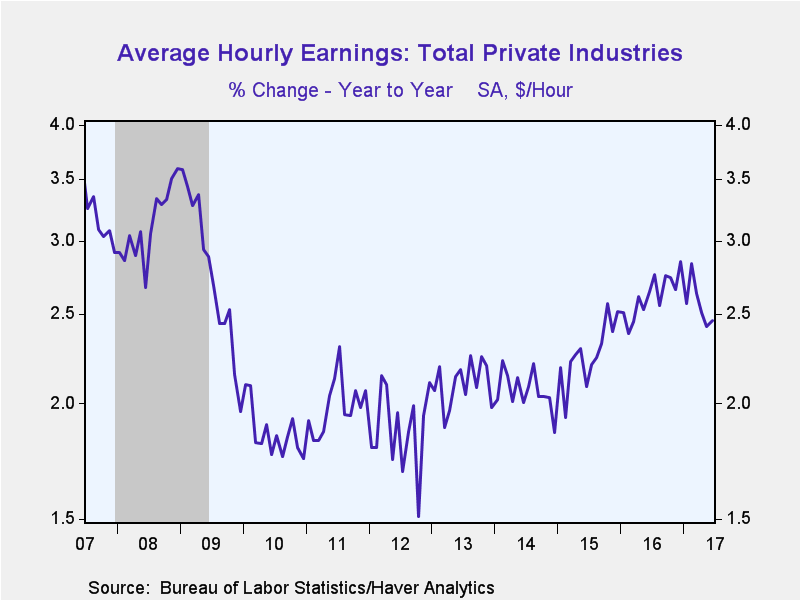 The 0.2% improvement in average hourly earnings left the 2.5%
y/y gain reduced from December's 2.9% y/y rise. Factory sector earnings rose a
reduced 2.1% y/y and construction sector earnings also were depressed at 2.5%
y/y. Private service sector earnings rose a slightly reduced 2.5% y/y reflecting
an increased 4.8% rise in the information sector. The gain in leisure &
hospitality earnings was lower at 4.0% y/y. Financial sector earnings increased
an accelerated 3.1% y/y, while professional & business service sector
earnings rose a lessened 2.3% y/y.
The 0.2% improvement in average hourly earnings left the 2.5%
y/y gain reduced from December's 2.9% y/y rise. Factory sector earnings rose a
reduced 2.1% y/y and construction sector earnings also were depressed at 2.5%
y/y. Private service sector earnings rose a slightly reduced 2.5% y/y reflecting
an increased 4.8% rise in the information sector. The gain in leisure &
hospitality earnings was lower at 4.0% y/y. Financial sector earnings increased
an accelerated 3.1% y/y, while professional & business service sector
earnings rose a lessened 2.3% y/y.
From the household sector, the rise in the unemployment rate to 4.4% reflected a 245,000 increase (1.4% y/y) in employment and a 361,000 gain (0.8% y/y) in the labor force. The labor force participation rate ticked up to 62.8%, but remained below the 63.0% high three months ago. The average duration of unemployment was stable m/m at 24.7 weeks, down from 27.7 weeks twelve months earlier.
By educational attainment, the unemployment rate for individuals with less than a high school diploma was 6.4%, down from 7.5% last June. The rate for high school graduates but no college was 4.6% versus 5.1% a year ago. Individuals with less than a bachelors' degree were 3.8% unemployed versus 4.2% last June, while college graduates were 2.4% unemployed, down from 2.6% twelve months earlier.
The teenage unemployment rate fell sharply to 13.3%, the lowest level since 2001. The rate for those aged 20-24 years rose to 7.5%. Unemployment for individuals aged 25 to 54 averaged 3.8%, while for those over age 55 it was 3.2%.
The labor market data are contained in Haver's USECON database. Detailed figures are in the EMPL and LABOR databases. The expectations figure is in the AS1REPNA database.
| Employment: (SA, M/M Change, 000s) | Jun | May | Apr | Jun Y/Y | 2016 | 2015 | 2014 |
|---|---|---|---|---|---|---|---|
| Payroll Employment | 222 | 152 | 207 | 1.5% | 1.7% | 2.1% | 1.9% |
| Previous | -- | 138 | 174 | -- | -- | -- | -- |
| Manufacturing | 1 | -2 | 9 | 0.4 | 0.1 | 1.2 | 1.4 |
| Construction | 16 | 9 | 0 | 3.0 | 3.9 | 5.0 | 5.0 |
| Private Service-Producing | 162 | 146 | 175 | 1.7 | 2.1 | 2.4 | 2.1 |
| Government | 35 | -7 | 13 | 0.6 | 0.9 | 0.7 | 0.1 |
| Average Weekly Hours - Private Sector | 34.5 | 34.4 | 34.5 | 34.4 | 34.4 | 34.5 | 34.5 |
| Private Sector Average Hourly Earnings (%) | 0.2 | 0.1 | 0.2 | 2.5 | 2.6 | 2.3 | 2.1 |
| Unemployment Rate (%) | 4.4 | 4.3 | 4.4 | 4.9 | 4.8 | 5.3 | 6.2 |
Tom Moeller
AuthorMore in Author Profile »Prior to joining Haver Analytics in 2000, Mr. Moeller worked as the Economist at Chancellor Capital Management from 1985 to 1999. There, he developed comprehensive economic forecasts and interpreted economic data for equity and fixed income portfolio managers. Also at Chancellor, Mr. Moeller worked as an equity analyst and was responsible for researching and rating companies in the economically sensitive automobile and housing industries for investment in Chancellor’s equity portfolio. Prior to joining Chancellor, Mr. Moeller was an Economist at Citibank from 1979 to 1984. He also analyzed pricing behavior in the metals industry for the Council on Wage and Price Stability in Washington, D.C. In 1999, Mr. Moeller received the award for most accurate forecast from the Forecasters' Club of New York. From 1990 to 1992 he was President of the New York Association for Business Economists. Mr. Moeller earned an M.B.A. in Finance from Fordham University, where he graduated in 1987. He holds a Bachelor of Arts in Economics from George Washington University.


